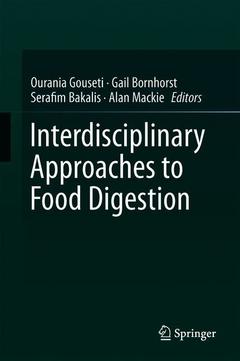Description
Interdisciplinary Approaches to Food Digestion, 1st ed. 2019
Coordinators: Gouseti Ourania, Bornhorst Gail M., Bakalis Serafim, Mackie Alan
Language: English
Subjects for Interdisciplinary Approaches to Food Digestion:
358 p. · 15.5x23.5 cm · Hardback
Description
/li>Contents
/li>Biography
/li>Comment
/li>
For the first time, this singular and comprehensive text presents a focus on quantitative studies aiming to describe food digestion and the tools that are available for quantification. A case study relevant to real-world applications places this theoretical knowledge in context and demonstrates the different ways digestion studies can be used to develop food products. Interdisciplinary Approaches to Food Digestion undertakes a multidisciplinary approach to food digestion studies, placing them in context and presenting relevant phenomena plus the challenges and limitations of different approaches. This book presents a unique, useful reference work to scientists, students, and researchers in the area of food science, engineering, and nutrition.
Over the last two decades there has been an increasing demand for foods that deliver specific nutritional values. In addition, the dramatic increase of food related diseases such as obesity requires the development of novel food products that control satiety and glycemic response. Overall, digestion studies are gaining increasing attention in recent years, especially as the link between diet and health/well-being becomes more evident. However, digestion is a complex process involving a wide range of disciplines such as medicine, nutrition, chemistry, materials science, and engineering. While a significant body of work exists within each discipline, there is a lack of a multidisciplinary approach on the topic which will provide a holistic view of the process. With Interdisciplinary Approaches to Food Digestion, researchers are finally presented with this much needed approach.
I. Interdisciplinary approaches of digestion
1. Why interdisciplinary? (Bornhorst, G., Gouseti, O., Bakalis, S)
2. Evolution of digestion studies (historical perspective) (Gouseti, O., Butterworth, P.J.)
3.
The digestive tract: a complex system (Mackie, A., Dupont, D)4. Current state: In-vivo, in-vitro, in-silico studies (Bornhorst, G., Gouseti, O., Bakalis, S)
II. Considerations during digestion studies
5. Challenges in quantifying digestion (Wickham, M.)
6. Food composition and structures (L. Lundin)7. From bite to nutrient: the importance of length scales (P. Singh, P.J. Fryer)
III. Quantitative characterisation of digestion processes
8.
Tools/methods for quantifying digestion: Medical Aspect (Marciani, L.)9. Tools/methods for quantifying digestion: Nutritional Aspect – (Ferruzzi, M)
10. Tools/methods for quantifying digestion: Food Chemistry Aspect (Gibson, G.)
11. Tools/methods for quantifying digestion: Material Sciences Aspect (U. Lesmes.)
12. Too
ls/methods for quantifying digestion: Food Engineering Aspect (Ferrua, M.J., Bornhorst, G.)
IV.
Case study: industrial relevance13. Starchy foods: contribution to public health – (I. McDonald)
14. Human nutrition (Brand-Miller, J.)
15. Digestion of carbohydrates (Ellis, P.)16. Engineering approach (Cleary, P.)
17. Integration of Scientific Studies to the Food Industry (B. LeReverend)
18. Challenges & Future: Opinions for the future of Food Research (Bornhorst, G., Gouseti, O., Bakalis, S, Lillford, P.)
Focuses on quantification studies of food digestion as well as the tools available to complete these studies
Presents an industrially relevant case study that demonstrates the different ways digestion studies can be used to develop food products
Presents a multidisciplinary approach to food digestion studies, putting the different methods into context and presenting the benefits, challenges and limitations of each approach
These books may interest you

The Physical Processes of Digestion 105.49 €



